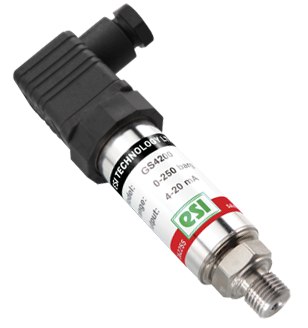 A pressure transducer, also known as a pressure sensor or pressure transmitter, is a device used to measure and convert pressure (force per unit area) into an electrical signal that can be read, recorded, or processed by instruments and control systems. Pressure transducers are used in a wide range of industrial, automotive and aerospace applications where monitoring and control of pressure are essential.
A pressure transducer, also known as a pressure sensor or pressure transmitter, is a device used to measure and convert pressure (force per unit area) into an electrical signal that can be read, recorded, or processed by instruments and control systems. Pressure transducers are used in a wide range of industrial, automotive and aerospace applications where monitoring and control of pressure are essential.
Here’s how a pressure transducer typically works:
-
Sensing Element: At the core of a pressure transducer is a sensing element that directly interacts with the applied pressure. This sensing element is designed to deform or react in response to changes in pressure.
-
Mechanical Deformation: When pressure is applied to the sensing element, it deforms or changes shape in a predictable manner. The extent of deformation is directly proportional to the magnitude of the applied pressure.
-
Electrical Output: The sensing element is typically connected to some form of electrical circuitry. This circuitry converts the mechanical deformation of the sensing element into an electrical signal, such as voltage, current, or resistance.
-
Signal Conditioning: In many cases, the raw electrical signal generated by the sensing element may need to be conditioned or amplified to make it suitable for measurement or control systems.
-
Output Signal: The conditioned electrical signal is then outputted by the pressure transducer. The output signal can be in analog form (e.g., 4-20 mA current signal or 0-5 V voltage signal) or digital form (e.g., digital communication protocols like CANbus).
Pressure transducers can be categorized into various types based on their sensing technologies and applications, including:
-
Strain Gauge Pressure Transducers: These use strain gauges attached to a diaphragm to measure pressure-induced strain.
-
Piezoelectric Pressure Transducers: These use piezoelectric materials that generate electrical charges when subjected to pressure-induced mechanical stress.
-
Capacitive Pressure Transducers: These measure pressure-induced changes in capacitance between two conductive plates.
-
Piezoresistive Pressure Transducers: These rely on the change in resistance of piezoresistive materials (materials whose resistance changes with strain) when subjected to pressure.
- High Temperature Pressure Transducers: A high-temperature pressure transducer is a specialized pressure sensor designed to operate accurately and reliably in elevated temperature environments. Standard pressure transducers may not be suitable for such conditions because they can be sensitive to high temperatures, which can cause damage to their components or lead to inaccurate readings. High-temperature pressure transducers are engineered to withstand and perform under these challenging conditions.
Pressure transducers are essential components in various applications, such as monitoring blood pressure in medical devices, measuring tire pressure in vehicles, controlling industrial processes, and monitoring pressure in pipelines and hydraulic systems. Their accuracy, reliability, and compatibility with different pressure ranges make them valuable tools for a wide range of industries and scientific disciplines.
